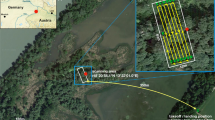Abstract
IT was chiefly due to the War that surveying from air photographs emerged from the state of being an ingenious but not very serious or practical method, into the condition of being in certain cases indispensable and in many cases of genuine value, and, it may be added, in all cases to be reckoned with. The history of the method ante-dates the invention of aeroplanes. It had been used with comparative success from balloons; and, in the British service, it was the late Col. Elsdale who developed the use of small free balloons, which travelled a sufficient distance to allow a series of plates to be exposed, and then upset themselves and came down to the ground. Photographs of this kind were taken so long ago as 1885.
Surveying from Air Photographs.
By Cap. M. Hotine. Pp. xi + 250 + 8 plates. (London: Constable and Co., Ltd., 1931.) 30s. net
This is a preview of subscription content, access via your institution
Access options
Subscribe to this journal
Receive 51 print issues and online access
$199.00 per year
only $3.90 per issue
Buy this article
- Purchase on Springer Link
- Instant access to full article PDF
Prices may be subject to local taxes which are calculated during checkout
Similar content being viewed by others
Rights and permissions
About this article
Cite this article
C., C. The New Surveying. Nature 128, 946–947 (1931). https://doi.org/10.1038/128946a0
Issue Date:
DOI: https://doi.org/10.1038/128946a0
Comments
By submitting a comment you agree to abide by our Terms and Community Guidelines. If you find something abusive or that does not comply with our terms or guidelines please flag it as inappropriate.



